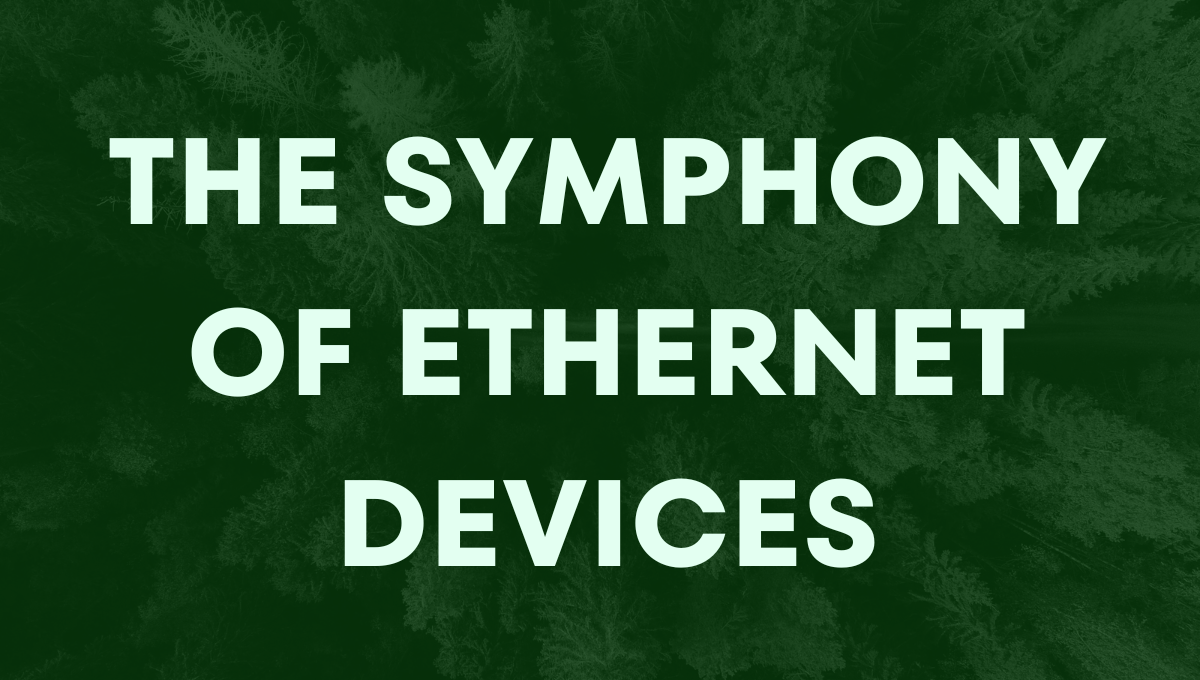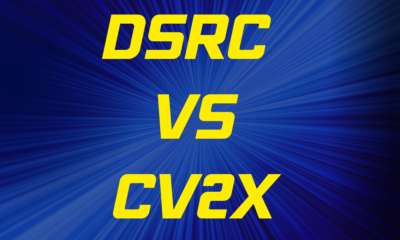Tech
The Symphony of Connectivity: Understanding Ethernet Devices
Welcome to the symphony of connectivity, where every note is played by Ethernet devices. In this digital era, where technology orchestrates our daily lives, understanding how these devices harmonize to keep us seamlessly connected becomes vital. From routers and switches to modems and network adapters, each instrument plays its unique role in creating an enchanting symphony that allows us to surf the web, stream movies, and communicate effortlessly. So join us as we dive into the world of Ethernet devices – a captivating ensemble that keeps our modern world humming with connectivity!
Published
2 years agoon
By
Marks Strand
In the fast-paced and interconnected digital era, the symphony of connectivity plays a pivotal role in our daily lives. At the heart of this harmonious symphony lie Ethernet devices, conducting a seamless flow of data, orchestrating communication, and ensuring that we stay connected with the world. In this article, we embark on a captivating journey to unravel the enigma behind these remarkable Ethernet devices – the Network Interface Device (NID), Network Termination Unit (NTU), and more.
I. Introduction
In a world where connectivity has become the lifeblood of our daily activities, Ethernet devices emerge as the unsung heroes of modern communication. They are the architects of interconnected networks, paving the way for seamless data transfer and smooth communication. Let’s delve into the realm of Ethernet devices and explore their magical capabilities that enable us to stay in touch with the world at our fingertips.
II. Unraveling the Enigma of Network Interface Devices (NID)
Our symphony begins with the mysterious Network Interface Device (NID), a vital component in the realm of telecommunications. Acting as a guardian between the service provider’s network and the customer’s premises, the NID ensures a safe and efficient flow of communication. It stands as a sentinel outside our buildings, where the service provider’s network links to our internal wiring. The NID is the gateway through which telecommunication services like internet, telephone, and digital TV enter our abode.
III. Venturing into the Enchanted Realm of Network Termination Units (NTU)
Beyond the boundaries of conventional communication lies the enchanted world of fiber-optic networks. In this realm, the Network Termination Unit (NTU) takes center stage. Gracefully terminating the fiber-optic cable, the NTU performs a mystical alchemy, converting optical signals into electrical ones. This transformation allows seamless integration with the customer’s internal network equipment, unlocking the wonders of high-speed data access. With its wisdom in error correction and signal regeneration, the NTU ensures the data journey remains filled with integrity and brilliance.
IV. The Symphony of Ethernet Devices: Harmonizing Data Flow
As the symphony unfolds, we encounter a dazzling ensemble of Ethernet devices, each playing a unique role in the orchestration of data flow.
- Ethernet Switches: The Master Conductors
Imagine a local area network (LAN) as a grand concert hall, where Ethernet switches take the center stage as the master conductors. Each device connected to an Ethernet switch becomes a virtuoso, with its dedicated communication channel. The switches deftly navigate data packets through the most efficient paths, ensuring a melodious flow of data, free from congestion and delays.
- Ethernet Routers: Adventurous Explorers of Networks
In the vast kingdom of networking, Ethernet routers play the part of adventurous explorers, forging paths between LANs and wide area networks (WANs). Like skilled cartographers, they chart the best routes for data to traverse, transcending geographical boundaries and bridging distant realms. Their intelligence in network topology and traffic conditions makes every data journey an epic tale of connectivity.
- Ethernet Adapters: The Magicians of Connection
Enter the enchanting world of Ethernet adapters, the magicians of connection. These mystical network interface cards (NICs) enchant our devices, granting them access to the secrets of the network. With their spellbinding abilities, they enable seamless communication and data exchange among our beloved devices, weaving a tapestry of connectivity in the digital realm.
- Ethernet Extenders: The Time Travelers of Networking
When distance seems like an insurmountable obstacle, Ethernet extenders come to the rescue as the time travelers of networking. With their otherworldly prowess, they extend the reach of network connections beyond standard limitations, bridging gaps between far-off locations and connecting devices in remote realms.

V. The Future Symphony of Connectivity: Advancements and Outlook
As technology pushes the boundaries of innovation, the symphony of Ethernet devices continues to evolve and adapt. Emerging technologies promise even greater speed, reliability, and efficiency in data communication. The future prospects of NID, NTU, and Ethernet devices hold the promise of building interconnected, reliable, and high-speed networks for a world that thrives on seamless connectivity.
The symphony of connectivity, led by the magical prowess of Ethernet devices, will continue to shape our digital experiences. From the guardianship of NID to the enchantment of NTU and the brilliance of Ethernet switches, routers, adapters, and extenders, these devices unite to create a harmonious symphony of communication. With the quest for seamless connectivity propelling us forward, the future of networking and communication holds the promise of a world forever connected in a symphony of digital dreams.
FAQs
- Q: What is the role of a Network Interface Device (NID) in telecommunications? A: The Network Interface Device (NID) serves as the boundary between the service provider’s network and the customer’s premises. It allows telecommunication services to be delivered to the customer’s location and acts as a protective boundary, separating the responsibilities of the service provider and the customer.
- Q: Where is the Network Interface Device (NID) typically installed? A: The NID is usually located outside a building, where the service provider’s network connects to the customer’s internal wiring. It serves as the entry point for telecommunication services to the customer’s location.
- Q: What does the Network Termination Unit (NTU) do in fiber-optic networks? A: The Network Termination Unit (NTU) plays a crucial role in fiber-optic connections. It terminates the fiber-optic cable and converts the optical signal to an electrical signal, allowing seamless integration with the customer’s internal network equipment.
- Q: What are the benefits of using the Network Termination Unit (NTU) in fiber-optic networks? A: The NTU provides reliable and fast data communication through fiber-optic networks. By converting optical impulses to electrical signals, typical networking equipment like routers and switches can better interpret and process the data. The NTU also enables error correction and signal regeneration, ensuring data integrity and quality.
- Q: How do Ethernet switches contribute to network communication? A: Ethernet switches act as master conductors in local area networks (LANs), allowing direct communication between devices. Each device connected to an Ethernet switch has its own dedicated communication channel, ensuring fast data transfer and reducing network congestion.
- Q: What role do Ethernet routers play in a network? A: Ethernet routers interconnect networks, enabling seamless communication between LANs and wide area networks (WANs). They determine the best path for data to travel between networks, making intelligent decisions based on network topology and traffic conditions.
- Q: How do Ethernet adapters facilitate communication between devices? A: Ethernet adapters, also known as network interface cards (NICs), are essential for connecting devices like computers, servers, and printers to the network. They enable these devices to communicate with each other and access network resources.
- Q: What is the purpose of Ethernet extenders? A: Ethernet extenders are used to extend the reach of Ethernet connections beyond the standard distance limitations. They enable data transmission over longer distances, making them ideal for connecting devices in remote locations where running new network cables is impractical.
- Q: Why are Ethernet devices crucial for modern networking? A: Ethernet devices form the foundation of modern networking, enabling smooth data transmission and seamless communication within and between networks. Ethernet switches, routers, adapters, and extenders play essential roles in building reliable and efficient networks.
- Q: How will NID, NTU, and Ethernet devices shape the future of communication and networking? A: NID and NTU will continue to play critical roles in ensuring seamless communication between service providers and customers, especially with the increasing demand for high-speed data. Ethernet devices will continue to evolve and adapt to new technologies, enabling the development of interconnected, reliable, and high-speed networks for a connected world.
You may like
Business Solutions
Geneo Glam: Skin Firming Treatment for Radiant, Youthful Skin
Geneo Glam is the ultimate skin firming treatment designed to restore elasticity, enhance radiance, and leave you with a glowing, youthful complexion.
Published
12 hours agoon
May 9, 2025By
Marks Strand
The Geneo Glam skin firming treatment is a luxurious, non-invasive facial that revitalizes the skin by improving firmness, elasticity, and hydration. Using advanced OxyPod technology, this treatment delivers a unique combination of exfoliation, oxygenation, and infusion of active ingredients to help the skin look smoother, tighter, and more radiant.
Key Benefits
- Firms and Hydrates
The treatment boosts collagen and elastin production, helping skin feel firmer and more supple. - Improves Elasticity
Increases the skin’s resilience and reduces the appearance of fine lines and wrinkles. - Prevents Collagen Breakdown
Helps preserve the skin’s youthful structure by protecting existing collagen and supporting healthy cell function.
Powerful Natural Ingredients
- 24K Gold Particles
Stimulate collagen production, protect skin fibers, and encourage cell renewal for a firmer, lifted appearance. - Silk Amino Acids
Strengthen the skin barrier, lock in moisture, and support collagen synthesis to reduce visible signs of aging. - Carnosine Peptides
Help protect the skin from sugar-related damage (glycation), delay cellular aging, and extend the life of skin cells. - Copper
An antioxidant and anti-inflammatory that supports collagen development, smooths fine lines, and helps with skin regeneration.
How the Treatment Works
- Exfoliation and Oxygenation
The Geneo Glam OxyPod is activated with a Primer Gel, gently exfoliating the skin and triggering a natural oxygenation process that increases blood flow and enhances skin vitality. - Infusion of Actives
Active ingredients such as gold particles, peptides, and amino acids are infused deep into the skin to firm and rejuvenate. - Hydration and Nourishment
A final serum containing hyaluronic acid, rosehip oil, and marula oil hydrates and soothes the skin, leaving it soft and glowing.
Who Should Try Geneo Glam?
This treatment is ideal for people who want to:
- Reduce fine lines and early signs of aging
- Firm and tighten sagging skin
- Restore hydration and improve skin tone
Geneo Glam offers a refreshing way to firm, lift, and hydrate your skin—leaving you with a youthful glow and smooth, resilient skin. It’s a perfect solution for anyone seeking visible results without invasive procedures or downtime.
Business Solutions
H.265 miniature UAV encoders: A comprehensive Overview
H.265 miniature UAV encoders revolutionize aerial technology with advanced video compression, ensuring high efficiency and superior performance for modern UAV systems.
Published
2 days agoon
May 8, 2025By
Adva
As the demand for high-quality, real-time video transmission from unmanned aerial vehicles (UAVs) continues to rise in both military and commercial applications, the need for efficient, compact video encoding solutions has become paramount. H.265 miniature UAV encoders represent a significant advancement in this space, providing robust video compression in a small, lightweight package ideal for drones with stringent size, weight, and power (SWaP) constraints. Leveraging the power of High Efficiency Video Coding (HEVC), also known as H.265, these encoders allow UAVs to deliver high-resolution video over constrained data links, enhancing situational awareness and operational effectiveness without overwhelming available bandwidth.
H.265 is a video compression standard that succeeds H.264/AVC and offers approximately double the data compression ratio at the same video quality level. This efficiency is particularly beneficial for UAV applications, where bandwidth and power availability are limited, especially during beyond-line-of-sight (BLOS) missions or in contested environments. With H.265 encoders, UAVs can stream 1080p or even 4K encoder video in real time while consuming significantly less data than older standards. This is critical for operations such as intelligence, surveillance, and reconnaissance (ISR), where maintaining video clarity over long distances or through relay networks is essential for accurate decision-making.
Miniature H.265 UAV encoders are engineered to operate under harsh environmental conditions while maintaining optimal performance. These devices are typically ruggedized, featuring extended temperature ranges, shock resistance, and electromagnetic shielding to ensure reliable operation in military or field environments. Despite their small size—often no larger than a deck of cards—they include advanced features such as low-latency encoding, dynamic bitrate control, encryption, and support for multiple streaming protocols including RTSP, RTP, and MPEG-TS. This allows them to integrate seamlessly into existing command-and-control infrastructure and support a variety of end-user applications, from real-time ground monitoring to autonomous navigation and object tracking.

The integration of H.265 encoders into small UAVs has significantly expanded the capability of tactical drone systems. For example, military units can deploy hand-launched drones equipped with these encoders to provide persistent ISR coverage over a battlefield, transmitting clear, actionable video intelligence back to command centers in near real time. Law enforcement agencies and border security forces also benefit from these technologies, using UAVs to monitor large or remote areas with minimal personnel. In disaster response scenarios, such encoders enable drones to deliver live aerial assessments of affected regions, helping responders prioritize actions and coordinate relief efforts efficiently.
Beyond video transmission, modern H.265 UAV encoders are increasingly integrated with onboard artificial intelligence modules that enable edge processing. This allows UAVs to perform real-time object recognition, motion detection, and scene analysis directly within the encoder, reducing the need to send raw data to centralized systems for processing. Such capabilities are crucial in time-sensitive missions where latency can affect outcomes, such as tracking moving targets or identifying threats in complex terrain.
Despite their many advantages, the deployment of H.265 miniature encoders does come with some technical considerations. The encoding process, while more efficient than previous standards, requires higher computational resources. Manufacturers must therefore strike a careful balance between processing power, thermal management, and energy consumption. Additionally, the compatibility of H.265 streams with legacy systems remains a factor, as not all ground stations or video players natively support HEVC decoding without updates or specialized software.
Manufacturers of H.265 miniature UAV encoders include companies such as IMT Vislink, Soliton Systems, Haivision, and VITEC, all of which provide solutions tailored to UAV and robotics applications. These encoders are often modular, allowing integrators to select configurations based on mission requirements, payload limitations, and transmission needs. As the ecosystem of compact, high-efficiency video systems grows, continued innovation in low-power silicon and AI integration is expected to drive the next wave of capability enhancements in this field.
In the evolving landscape of drone technology, H.265 miniature UAV encoders stand out as a critical enabler of high-performance video transmission. By combining advanced compression with minimal SWaP impact, these systems provide UAV operators with the tools to observe, analyze, and act with unprecedented precision and clarity—no matter how small the platform or how demanding the environment.
Business Solutions
IEEE 802.11p and V2X Communication: Enabling Smarter, Safer Roads
IEEE 802.11p revolutionizes V2X communication, driving smarter, safer roads through advanced vehicle connectivity. This cutting-edge technology enhances transportation systems, enabling intelligent and secure interactions for a safer future.
Published
2 days agoon
May 7, 2025By
Adva
Modern vehicles are no longer isolated machines; they are becoming intelligent, connected nodes within a larger transportation ecosystem. At the heart of this transformation is Vehicle-to-Everything (V2X) communication, which enables cars to talk to each other and to the infrastructure around them. One of the first and most influential technologies developed to support V2X is the IEEE 802.11p standard—a wireless standard specifically tailored for vehicular environments.
What is IEEE 802.11p?
IEEE 802.11p is an amendment to the IEEE 802.11 standard (commonly known as Wi-Fi), designed to enable wireless access in vehicular environments. It was approved in 2010 and forms the basis for Dedicated Short-Range Communications (DSRC).
Key Characteristics of 802.11p:
- Frequency Band: Operates in the 5.9 GHz band reserved for Intelligent Transportation Systems (ITS).
- Low Latency: Optimized for fast, real-time communication necessary for safety-critical applications.
- Range: Effective communication range of up to 1 kilometer, suitable for high-speed vehicle interaction.
- Decentralized Architecture: Enables direct communication (V2V and V2I) without the need for cellular or network infrastructure.
- Robustness: Handles high-speed mobility and rapidly changing topologies typical of vehicular environments.

Role of 802.11p in V2X Communication
V2X (Vehicle-to-Everything) is a broader term encompassing various communication paradigms, including:
- V2V (Vehicle-to-Vehicle)
- V2I (Vehicle-to-Infrastructure)
- V2P (Vehicle-to-Pedestrian)
- V2N (Vehicle-to-Network)
- V2C (Vehicle-to-Cloud)
802.11p primarily supports V2V and V2I communications, forming the backbone of DSRC-based V2X implementations. Its low latency and direct communication capabilities make it ideal for applications such as:
- Forward collision warnings
- Intersection movement assist
- Emergency electronic brake lights
- Lane change warnings
Comparison with Cellular V2X (C-V2X)
As V2X technology has evolved, C-V2X (based on LTE and 5G standards) has emerged as a strong alternative to 802.11p. Here’s how they compare:
| Feature | IEEE 802.11p (DSRC) | C-V2X (LTE/5G) |
| Latency | ~10 ms | ~5–10 ms (LTE), <5 ms (5G) |
| Coverage | Short-range, direct | Short + long-range via network |
| Deployment | Mature, field-tested | Growing, especially with 5G |
| Infrastructure | Minimal (no cellular needed) | Requires cellular networks (for V2N/V2C) |
| Interoperability | Limited with C-V2X | Newer versions support dual-mode |
Adoption and Use Cases
Global Deployment:
- United States: Initially favored DSRC based on 802.11p, though recent FCC rulings have shifted focus toward C-V2X.
- Europe: ETSI has defined ITS-G5, a protocol stack based on 802.11p.
- Japan and South Korea: Active use of DSRC for tolling and traffic safety.
Real-World Applications:
- Collision avoidance systems
- Smart intersections
- Road hazard notifications
- Platooning for commercial vehicles
- Public transport priority systems
Advantages of 802.11p
- Mature and Proven: Used in numerous pilot programs and early deployments.
- Fast Time to Communication: No need for handshake protocols; devices can communicate almost instantly.
- No Subscription Costs: Operates independently of cellular networks.
Limitations and Challenges
- Scalability: In high-density traffic, packet collisions may reduce reliability.
- Spectrum Allocation: Regulatory changes in some countries have limited the bandwidth available to DSRC.
- Limited Ecosystem Growth: Many automakers and countries are shifting investment to C-V2X and 5G-based platforms.
Future Outlook
While 802.11p has laid the foundation for V2X communication, the industry is gradually pivoting toward more advanced and scalable technologies such as 5G NR-V2X. However, 802.11p remains relevant in regions where DSRC infrastructure is already deployed and continues to serve as a dependable option for immediate, low-latency vehicular communication.
Hybrid Solutions:
Some industry players are exploring dual-mode V2X devices that support both 802.11p and C-V2X, ensuring backward compatibility and smoother transitions.
IEEE 802.11p has played a pivotal role in launching the era of connected vehicles, offering reliable, low-latency communication tailored for high-speed mobility. While newer technologies like C-V2X and 5G are beginning to dominate the roadmap, 802.11p’s contributions remain foundational in the evolution of V2X systems. As the automotive industry moves forward, a mix of technologies, including legacy support for 802.11p, will ensure that safety, efficiency, and connectivity continue to advance on roads around the world.

Geneo Glam: Skin Firming Treatment for Radiant, Youthful Skin

H.265 miniature UAV encoders: A comprehensive Overview

IEEE 802.11p and V2X Communication: Enabling Smarter, Safer Roads
Trending
-
Marketing & Analytics2 years ago
A Complete Guide To HubSpot’s New B2B Marketing, Sales Hub, and Prospecting Tool
-
3D Technology2 years ago
3D Scanner Technology for Android Phones: Unleashing New Possibilities
-
Marketing & Analytics2 years ago
How SMS Services And Software For Bulk SMS Sending Can Help Your Business Grow
-
3D Technology2 years ago
Mobile 3D Scanners: Revolutionizing 3D Scanning Technology
-
3D Technology2 years ago
3D scanning technologies and scanning process
-
Business Solutions1 year ago
Understanding A2P Messaging and the Bulk SMS Business Landscape
-

 Business Solutions1 year ago
Business Solutions1 year agoThe Power of Smarts SMS and Single Platform Chat Messaging
-

 Automotive2 years ago
Automotive2 years agoDSRC vs. CV2X: A Comprehensive Comparison of V2X Communication Technologies




